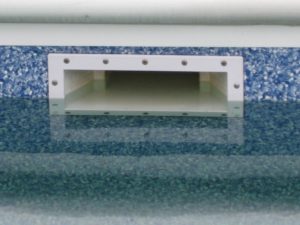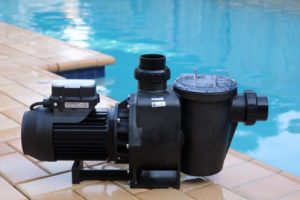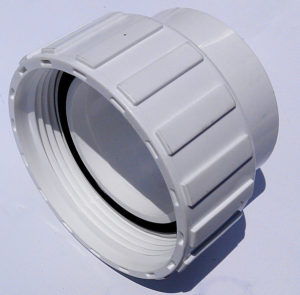Trying to figure out how to fix air bubbles in your pool? Keep reading, because this post explains how.
Why are my pool jets blowing bubbles?
At one point or another, every pool owner will notice air bubbles coming out of their pool’s return jets. Luckily, getting down to the root of the problem is pretty easy. Most of the time, it’s all just a matter of knowing where to look.
But you’re probably wondering why air bubbles are really even considered a problem? They don’t affect your pool chemistry or harm your filter or pool heater, so what’s the big deal?
Allow us to explain.
Why you need to fix air bubbles in your pool
Air bubbles are pretty harmless to us, but as a pool owner, you know there shouldn’t be a lot of them in your water. That’s because air bubbles signify a leak in your pool system. A leak that reduces the effectiveness of your pool pump, and makes maintaining consistent water pressure a challenge. All which can affect both the performance of your filter, and pool water circulation.
But we’re here to walk you through exactly how to fix air bubbles in your pool. Do note that the fixes we’re covering in this post are for the purpose of fixing an air leak on the suction side of the pool pump.
How to Fix Air Bubbles In Your Pool
Water level



If you see air bubbles flowing into your pump basket, then your water level can very likely be the cause.
When your water level is low, your pool pump begins drawing in air from the skimmer. When your pump pulls in air, it’s circulated into your water flow, creating air bubbles. But when a pump runs for too long with little to no water it heats up, working much harder than it’s meant to. This is why it’s so important to regularly monitor your pool’s water level.
Keep your water level aligned with the middle of your skimmer. Or in other words, half of your skimmer opening should be below the water line and the other half, above.
+Skimmer door
Some pool skimmers have a moving flap that opens and closes as water enters. These are meant to trap any large debris and prevent it from reentering the water, but every now and then, these doors get jammed. And when the doors are jammed, water isn’t able to enter the skimmer, which eventually causes it to start pulling in air.
If there’s debris preventing the door from moving, simply remove it and mobility should be restored. Otherwise, your skimmer door may be too worn out, making it the right time to buy a replacement.
But if your skimmer and water level aren’t the cause, it could very well be your pump.
Pump


 As essential to your pool system as your pump is, it presents a number of opportunities for leaks to form. Leaks that are mostly natural results of wear and tear, but inconvenient nonetheless. In the same light, each area also presents a possible solution to fix air bubbles in your pool, so it’s really a matter of perspective.
As essential to your pool system as your pump is, it presents a number of opportunities for leaks to form. Leaks that are mostly natural results of wear and tear, but inconvenient nonetheless. In the same light, each area also presents a possible solution to fix air bubbles in your pool, so it’s really a matter of perspective.
Luckily, identifying the problem area is pretty straight forward.
NOTE: Turn off your pool pump at the breaker before you start inspecting it
+Cracked lid
Check the lid of your pool pump first. If you spot a crack of noticeable size, then you’ve already found a probable suspect for where the leak is coming from. Since water flow in your pool system is highly pressurized, and your pool pump is the primary transporter of water, any leaks within the pump can allow extra air to find its way into the water.
+Worn or damaged O-Ring
If your lid is in good shape, then flip it upside down and look for a rubber ring running along the edge of the lid. This is the o-ring, and its sole purpose is to ensure a sung air-tight fit when you reattach your lid.
Check your O-ring for any cracks or dry rot. If the O-ring looks anything but smooth and elastic, replacing it is beneficial.
+Drain plugs
This last one is uncommon, but still possible, so check it out anyway.
Your pool pump has at least one drain plug for quickly emptying out any stored water. Over time, the plug may get worn down from frequent handling, reducing its sealing capability. If the plug looks worn or appears to be letting water out of the pump, replace it.
Pump | Motor
The heart of your pool pump is, of course, the motor that powers it. Within the housing of your pool pump lies the motor, as well as a few other essential parts, including the shaft, shaft seal, and impeller.
+Shaft seal
The shaft seal is what separates the mechanical section of pump from the “water handling” section (where the impeller is located). If the seal becomes too worn, a leak can form within the pump causing air to enter through it.
If you suspect your pool pump is the problem, then a swimming pool service would be the fastest and most reliable solution. Whether you need pool pump repair or replacement, they can help.
[In the meantime, check out this guide on how to troubleshoot your pool pump]
-Unions


 Unions connect the individual sections of your pool system, but over time, even they’re subject to forming leaks.
Unions connect the individual sections of your pool system, but over time, even they’re subject to forming leaks.
NOTE: Before unscrewing any unions, make sure your pool pump is off
+O-rings and Connectors
As you unscrew the connector for each union, you’ll notice they’re very similar to your pump lid. From the threading along the inner wall of the connector to the O-ring residing within it.
If the O-ring is dry rotted or cracked, replace it. If not, make sure that it’s seated properly and not sticking out.
And of course, if you notice a major crack in the connector or the threading is worn down, then you’re likely not getting an air tight seal from it.
Simply replace what is worn to restore the seal.
-Three-Way Valve
Last but not least is your three-way valve, a movable “switch” located right near your pump and filter setup. This valve allows your to control water flow between your skimmers, pump, and main drain. Typically, these valves last quite a long time before any serious wear begins to set in. But with enough use, the valves may start leaking water simply due to loose seals or cracks from old age, in which case replacement is the best solution.
Closing Thoughts
If you went through every step of this blog post, then it’s highly likely that you figured out how to fix air bubbles in your pool. But if not, it might help to enlist the expert help of a swimming pool service. They can inspect your pool equipment at a deep level, and get down to the bottom of the issue.
Meanwhile, if you have any other questions about pool ownership, or are currently researching pool heating options, we recommend you check out these posts:
–How To Choose The Best Pool Heater


